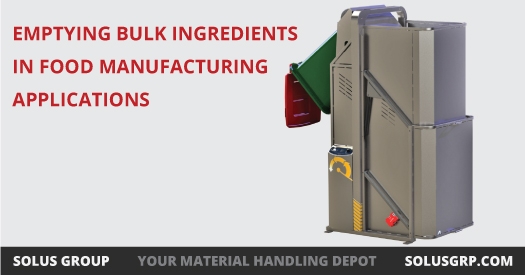We use cookies to make your experience better. To comply with the new e-Privacy directive, we need to ask for your consent to set the cookies. Learn more.
Emptying Bulk Ingredients in Food Manufacturing Applications
Bin Dumpers solve a host of problems in the food manufacturing and processing industries. These kitchen workhorses lift and dump heavy loads of bulk ingredients, allowing companies to run safer, leaner, and more productive operations.
Compliance with the safety rules set by the Occupational Safety and Health Administration (OSHA) and the Food and Drug Administration (FDA) can be tricky. Heavy-duty, stainless steel Bin Dumpers from Solus Group are designed and manufactured with these regulations in mind—which makes the workplace more satisfying for both staff and employers.
Protecting Workers and Complying With OSHA
OSHA oversees any workplace situation that could endanger employee health or well-being. While many of their concerns involve life or death consequences, the administration also aims to protect workers from injuries that may not be as obvious, like tripping hazards or poor ergonomics.
Lifting and dumping raw ingredients in buckets, vats, or packages poses a major ergonomic risk to food manufacturing workers. And while operations could dedicate more staff for joint lifting, this isn't always the most efficient solution.
Instead, providing portable Bin Dumpers allows one staff member to lift and dump ingredients in a safe and controlled manner. These material dumpers can handle hundreds of pounds of ingredients in a large variety of bins and containers. With the power of a Bin Dumper, one worker can do the work of many without risking a serious injury.
Meeting the FDA's Guidelines With Kitchen Equipment
Kitchens and manufacturing facilities may be hesitant to bring powered equipment into their clean spaces. Both OSHA (1910.22) and the FDA (Food Code) require a degree of sanitation that is hard to meet with some machines. 
The FDA's Food Modernization and Safety Act requires even more attention to contamination at different parts of the supply chain. An automatic dumper may meet OSHA's regulations for worker safety, but food production sanitation rules are a different story altogether.
The Dumpmaster from Solus Group aims to solve this problem with a stainless steel option for the 660-pound capacity tipper. The steady, controlled lifting motion prevents splashes and spills, but any drop of ingredient that does end up on the tipper washes off quickly and easily.
Stainless Steel: the Preferred Material for Food-Contact Surfaces
Of course, Bin Dumpers themselves don't ordinarily come into contact with food — they lift the containers that hold the ingredient. But by the FDA's strict definition of the term, ingredient tippers could well be considered a "food-contact surface," depending on the application.
According to a University of Florida study, food-contact surfaces should be smooth, nonabsorbent, corrosion-resistant, and cleanable. The authors of the study found that stainless steel meets all of their recommended criteria, and they recommend it as the preferred material for food equipment.
Stainless steel Bin Dumpers meet all of the challenges of a busy food manufacturing or service operation. They make lifting easier and faster for workers, they're easy to clean, they're portable, and they require minimal maintenance while dependably performing the crucial task of lifting and dumping ingredients. In short, stainless steel Bin Dumpers offer the ideal method of emptying bulk ingredients into mixers and hoppers in food manufacturing plants.
References:"29 CFR 1910.22 - Walking-Working Surfaces General requirements." OSHA. Occupational Safety and Health Administration, U.S. Department of Labor, n.d. Web. 20 Nov. 2017.
Erickson, Daniel and Ronald Schmidt. "Sanitary Design and Construction of Food Equipment." IFAS. University of Florida IFAS Extension, May 2005. Web. 20 Nov. 2017.
"FDA Food Safety Modernization Act (FSMA)." FDA. Food and Drug Administration, U.S. Department of Health and Human Services, 17 Nov. 2017. Web. 20 Nov. 2017.
"Food Code." FDA. Food and Drug Administration, U.S. Department of Health and Human Services, 2013. Web. 20 Nov. 2017.
